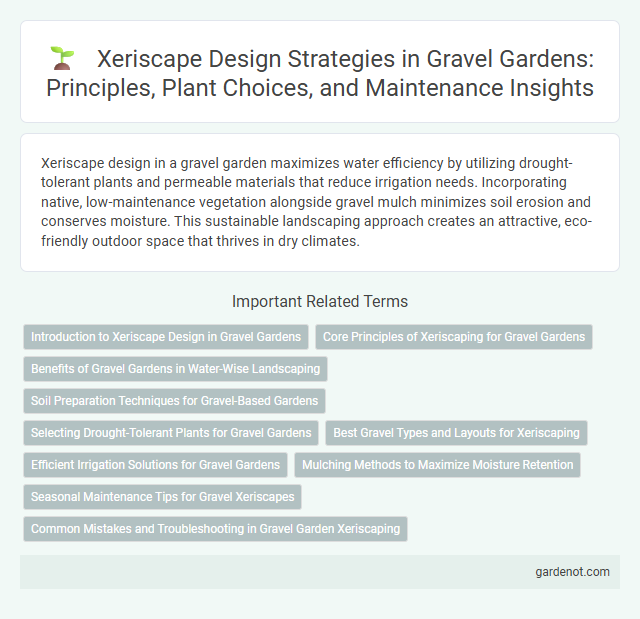Xeriscape design in a gravel garden maximizes water efficiency by utilizing drought-tolerant plants and permeable materials that reduce irrigation needs. Incorporating native, low-maintenance vegetation alongside gravel mulch minimizes soil erosion and conserves moisture. This sustainable landscaping approach creates an attractive, eco-friendly outdoor space that thrives in dry climates.
Introduction to Xeriscape Design in Gravel Gardens
Xeriscape design in gravel gardens emphasizes water-efficient landscaping by incorporating drought-tolerant plants, mulching with gravel to reduce evaporation, and strategic plant placement to maximize shade and minimize water use. Utilizing native and adapted species such as succulents, ornamental grasses, and Mediterranean herbs enhances sustainability while maintaining aesthetic appeal. The gravel mulch not only conserves soil moisture but also suppresses weed growth, creating a low-maintenance and eco-friendly garden environment.
Core Principles of Xeriscaping for Gravel Gardens
Xeriscape design in gravel gardens emphasizes water conservation through seven core principles: soil improvement, efficient irrigation, appropriate plant selection, mulching, landscape design, practical turf areas, and maintenance. Utilizing drought-tolerant plants such as succulents and native grasses promotes resilience and reduces water use. Incorporating high-quality gravel mulch not only minimizes evaporation but also supports soil health and controls weed growth, creating a sustainable, low-maintenance garden environment.
Benefits of Gravel Gardens in Water-Wise Landscaping
Gravel gardens in xeriscape design significantly reduce water consumption by promoting efficient drainage and minimizing evaporation, making them ideal for drought-prone regions. The use of gravel as a mulch helps suppress weed growth and maintain soil moisture, reducing the need for frequent irrigation. Integrating native drought-tolerant plants with gravel enhances soil health and biodiversity while creating a sustainable, low-maintenance landscape.
Soil Preparation Techniques for Gravel-Based Gardens
Effective soil preparation techniques for gravel-based xeriscape gardens prioritize soil drainage and nutrient retention to support drought-tolerant plants. Amending soil with organic matter, such as compost, enhances water absorption while preventing compaction, which is crucial for maintaining the gravel layer's permeability. Utilizing soil conditioners and ensuring proper grading facilitates root growth and minimizes water runoff, optimizing plant health in arid garden environments.
Selecting Drought-Tolerant Plants for Gravel Gardens
Selecting drought-tolerant plants for gravel gardens enhances water conservation and promotes sustainable xeriscape design. Species such as lavender, sedum, and ornamental grasses thrive in well-drained, low-moisture soils typical of gravel gardens. Incorporating native, drought-resistant shrubs alongside succulents further reduces irrigation needs while adding texture and color to the landscape.
Best Gravel Types and Layouts for Xeriscaping
Choosing the best gravel types for xeriscaping is crucial, with options like decomposed granite, pea gravel, and crushed granite offering excellent drainage and weed control. Effective gravel layouts incorporate layered designs, starting with a landscape fabric base to prevent weed growth, followed by a 2-3 inch gravel layer for optimal water retention and soil protection. Properly selected and arranged gravel not only enhances drought-resistant landscaping but also reduces maintenance and conserves water efficiently.
Efficient Irrigation Solutions for Gravel Gardens
Efficient irrigation solutions in xeriscape gravel garden design rely heavily on drip irrigation systems and soaker hoses that deliver water directly to plant roots, minimizing evaporation and runoff. Incorporating smart irrigation controllers with moisture sensors further optimizes water use by adjusting watering schedules based on real-time soil moisture data. These techniques ensure sustainable water conservation while maintaining healthy gravel garden landscapes.
Mulching Methods to Maximize Moisture Retention
Mulching methods in xeriscape gravel garden design significantly boost moisture retention by reducing evaporation and insulating soil temperatures. Organic mulches, such as bark or compost, gradually enrich the soil while inorganic options like gravel maintain a stable moisture environment without decomposing. Proper mulching thickness, typically 2-4 inches, optimizes water conservation and promotes plant health in arid landscaping.
Seasonal Maintenance Tips for Gravel Xeriscapes
Gravel xeriscapes require minimal seasonal maintenance, emphasizing periodic weed control with pre-emergent herbicides and manual removal to preserve the landscape's clean appearance. Inspect and replenish gravel mulch annually to maintain optimal depth for moisture retention and weed suppression, enhancing drought-resistant plant health. Regularly check irrigation systems to prevent overwatering, ensuring water efficiency and supporting the xeriscape's sustainable design.
Common Mistakes and Troubleshooting in Gravel Garden Xeriscaping
Overwatering remains a frequent mistake in gravel garden xeriscaping, leading to plant root rot and soil erosion. Poor plant selection, such as choosing species that require excessive water, undermines water conservation goals and hampers garden sustainability. Inadequate soil preparation and improper gravel depth can cause drainage issues and weed growth, necessitating regular assessment and adjustment to maintain optimal garden health.
Xeriscape design Infographic

 gardenot.com
gardenot.com